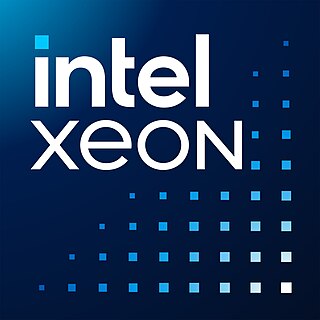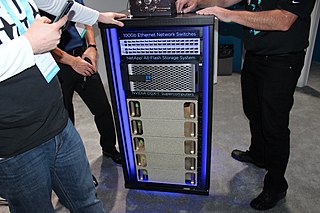
Itanium is a discontinued family of 64-bit Intel microprocessors that implement the Intel Itanium architecture. The Itanium architecture originated at Hewlett-Packard (HP), and was later jointly developed by HP and Intel. Launched in June 2001, Intel initially marketed the processors for enterprise servers and high-performance computing systems. In the concept phase, engineers said "we could run circles around PowerPC...we could kill the x86." Early predictions were that IA-64 would expand to the lower-end servers, supplanting Xeon, and eventually penetrate into the personal computers, eventually to supplant reduced instruction set computing (RISC) and complex instruction set computing (CISC) architectures for all general-purpose applications.

Xeon is a brand of x86 microprocessors designed, manufactured, and marketed by Intel, targeted at the non-consumer workstation, server, and embedded markets. It was introduced in June 1998. Xeon processors are based on the same architecture as regular desktop-grade CPUs, but have advanced features such as support for error correction code (ECC) memory, higher core counts, more PCI Express lanes, support for larger amounts of RAM, larger cache memory and extra provision for enterprise-grade reliability, availability and serviceability (RAS) features responsible for handling hardware exceptions through the Machine Check Architecture (MCA). They are often capable of safely continuing execution where a normal processor cannot due to these extra RAS features, depending on the type and severity of the machine-check exception (MCE). Some also support multi-socket systems with two, four, or eight sockets through use of the Ultra Path Interconnect (UPI) bus, which replaced the older QuickPath Interconnect (QPI) bus.

Altix is a line of server computers and supercomputers produced by Silicon Graphics, based on Intel processors. It succeeded the MIPS/IRIX-based Origin 3000 servers.
HPE Integrity Servers is a series of server computers produced by Hewlett Packard Enterprise since 2003, based on the Itanium processor. The Integrity brand name was inherited by HP from Tandem Computers via Compaq.
PowerLinux is the combination of a Linux-based operating system (OS) running on PowerPC- or Power ISA-based computers from IBM. It is often used in reference along with Linux on Power, and is also the name of several Linux-only IBM Power Systems.

The IBM BladeCenter was IBM's blade server architecture, until it was replaced by Flex System in 2012. The x86 division was later sold to Lenovo in 2014.
The Texas Advanced Computing Center (TACC) at the University of Texas at Austin, United States, is an advanced computing research center that is based on comprehensive advanced computing resources and supports services to researchers in Texas and across the U.S. The mission of TACC is to enable discoveries that advance science and society through the application of advanced computing technologies. Specializing in high-performance computing, scientific visualization, data analysis & storage systems, software, research & development, and portal interfaces, TACC deploys and operates advanced computational infrastructure to enable the research activities of faculty, staff, and students of UT Austin. TACC also provides consulting, technical documentation, and training to support researchers who use these resources. TACC staff members conduct research and development in applications and algorithms, computing systems design/architecture, and programming tools and environments.

IBM Power Systems is a family of server computers from IBM that are based on its Power processors. It was created in 2008 as a merger of the System p and System i product lines.
The National Center for Computational Sciences (NCCS) is a United States Department of Energy (DOE) Leadership Computing Facility that houses the Oak Ridge Leadership Computing Facility (OLCF), a DOE Office of Science User Facility charged with helping researchers solve challenging scientific problems of global interest with a combination of leading high-performance computing (HPC) resources and international expertise in scientific computing.

LGA 2011, also called Socket R, is a CPU socket by Intel released on November 14, 2011. It launched along with LGA 1356 to replace its predecessor, LGA 1366 and LGA 1567. While LGA 1356 was designed for dual-processor or low-end servers, LGA 2011 was designed for high-end desktops and high-performance servers. The socket has 2011 protruding pins that touch contact points on the underside of the processor.
Exalogic is a computer appliance made by Oracle Corporation, commercially available since 2010. It is a cluster of x86-64-servers running Oracle Linux or Solaris preinstalled.

POWER8 is a family of superscalar multi-core microprocessors based on the Power ISA, announced in August 2013 at the Hot Chips conference. The designs are available for licensing under the OpenPOWER Foundation, which is the first time for such availability of IBM's highest-end processors.

The National Computer Center for Higher Education, based in Montpellier, is a public institution under the supervision of the Ministry of Higher Education and Research (MESR) created by a decree issued in 1999. CINES offers IT services for public research in France. It is one of the major national centers for computing power supply for research in France.

ThinkStation is a brand of professional workstations from Lenovo announced in November 2007 and then released in January 2008. They are designed to be used for high-end computing and computer-aided design (CAD) tasks and primarily compete with other enterprise workstation lines, such as Dell's Precision, HP's Z line, Acer's Veriton K series, and Apple's Mac Pro line.
The Oracle Database Appliance (ODA) is a database server appliance made by Oracle Corporation. It was introduced in September 2011 as the mid-market offering in Oracle's family of full-stack, integrated systems the company calls engineered systems. The ODA is a single rack-mounted device providing a highly-available two-node clustered database server.
Intel Ivy Bridge–based Xeon microprocessors is the follow-up to Sandy Bridge-E, using the same CPU core as the Ivy Bridge processor, but in LGA 2011, LGA 1356 and LGA 2011-1 packages for workstations and servers.

PICO is an Intel Cluster installed in the data center of Cineca. PICO is intended to enable new "BigData" classes of applications, related to the management and processing of large quantities of data, coming both from simulations and experiments. The cluster is made of an Intel NeXtScale server, designed to optimize density and performance, driving a large data repository shared among all the HPC systems in Cineca.

The Nvidia DGX represents a series of servers and workstations designed by Nvidia, primarily geared towards enhancing deep learning applications through the use of general-purpose computing on graphics processing units (GPGPU). These systems typically come in a rackmount format featuring high-performance x86 server CPUs on the motherboard.
Coherent Accelerator Processor Interface (CAPI), is a high-speed processor expansion bus standard for use in large data center computers, initially designed to be layered on top of PCI Express, for directly connecting central processing units (CPUs) to external accelerators like graphics processing units (GPUs), ASICs, FPGAs or fast storage. It offers low latency, high speed, direct memory access connectivity between devices of different instruction set architectures.














